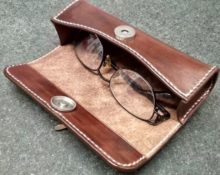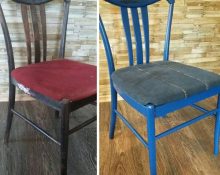
creativecommons.org
Any ottoman, like other furniture, loses its visual appeal over the years. The fabric is worn out and snags appear. However, this is not a reason to throw away your favorite pouf - the product can be restored, and you can do it yourself. Before covering an ottoman with fabric or other material, it is advisable to pay attention to choosing the appropriate material. In specialized stores you can find a variety of fittings and decorative elements. They will help you create an exclusive case for any interior.
How to cover an ottoman with fabric with your own hands - choosing the material
In order to extend the life of an ottoman or restore a piece of furniture, you will need a basic blank, foam rubber and material. Covers can be changed regularly, choosing products to match the color of the curtains or the season. Summer bright poufs can be covered with fur, fluffy capes in winter. Designers recommend taking a closer look at velvet, velor or suede for making a cover. Tapestry products, modern eco-leather and eco-fur are distinguished by good durability.
If there are no pets in the house who like to spend time on the ottoman, satin or brocade is suitable for decoration. The interior, decorated in ethnic style, will be complemented by furniture made of matting. Don't forget about the fashionable patchwork technique. Before covering the ottoman with fabric, you need to connect several different types of fabric together. This cover will not be easily soiled, it washes well and looks stylish. The sides can be made plain, in the color of one of the flaps.
How to sew a cover for a round ottoman
Round products are perfect for a children's room, living room or bedroom. According to experts, such ottomans can visually expand the total area of the room. In addition, smooth shapes make the interior less angular. General principles on how to cover an ottoman with fabric:
- We measure the circumference of the seat. To create a pattern you will also need the height of the chair. The layout can be made from whatman paper, but a newspaper will also do. Let's cut out the details of the cover.
- To check the parameters of the pattern, we will attach the fragments to the piece of furniture. They must fit in size.
- We cut out the fabric. Separately, we will cut out the details of the seat and four pockets from another fabric.
- Separately, cut out a strip of material. Its length is one and a half times longer than the length of the main layout. The width of the strip is five centimeters. This will be a frill.
- We sew the pockets along the top edge and insert elastic bands around the perimeter of the product. Now we sweep away all the parts and sew them with a machine.
- Sew a frill along the bottom and get a new elegant ottoman. Recycling fabric scraps can also be a creative process. For example, sew a pillowcase for a decorative pillow or make a cover for a chair or stool.

creativecommons.org
How to cover a round ottoman - options for leather covers
Restoring a leather ottoman is a more labor-intensive process, but it can be easily done. When choosing a model, it is important to consider the features of the material available:
- Covers made from scraps. If the fabric for the pouf is collected from scraps of leather, there are several options to create an original cape. You can work using the patchwork technique or make a multi-level cover. For example, the lower part can be made of a material of one color, above - a strip of a different shade, the seat - also different from the other elements;
- Working with applications. Burning leather is one of the common ways to create a unique design. Cut out a piece of skin, put it in a frying pan and heat it. The material will bend under the influence of hot air. You can work with it as with very soft raw materials. You can draw on the skin with a hot knitting needle or special stamps;
- Large piece of fabric. Working with a solid canvas is much easier. Simply sew the flaps, then attach them to the pouf and secure them. For fixation, you can use special nails;
- Lush covers. For such a product you will need a large amount of finely chopped fabric. These can be thin stripes, scales and other shapes. We sew all the parts together and fix them on a fabric base.
How to cover an ottoman with leather yourself
Before starting work, we will prepare the necessary tools and materials. You can take leather from old things and tear them apart. After this, we clean the flaps and paint over imperfections and abrasions. Using hand cream, lubricate the material and leave to absorb. To make an ottoman we will need:
- Plywood;
- Ruler, drill, furniture stapler;
- Jigsaw;
- Leather – one meter;
- Foam rubber - one meter;
- Tape measure for measuring.
Step-by-step instructions on how to make an ottoman from scratch:
- Divide the plywood into five parts and cut with a jigsaw.
- Carefully sand the edges of all elements using sandpaper or sandpaper.
- Collect all the fragments and place tags. Self-tapping screws will be placed along them.
- To create holes we use an electric drill. Use a screwdriver to tighten each screw. The base for the pouf is ready.
- We place foam rubber on the surface of the product. To do this, we apply the base to the material and cut it along the contours. We cover the edges of the frame with glue.
- We cut out the cover. We measure all sides of the pouf. We add four centimeters to the material for allowances. Let's fold this fabric inward.
- We sew the edge of the material along the top of the product. We connect the sides together and put the cover on the ottoman.


 0
0





